MOJAVE NATIONAL PRESERVE, Calif. - The rain started before I fell asleep and still hadn’t let up eight hours later. This hadn’t been much of a problem during the night; the sound of each drop hitting the polyester rain fly tent had drowned most of the background noise and helped lull me to sleep. Now that it was morning I had to leave my tent behind, hop into a Nissan Frontier Pro-4X and continue along the Mojave Road.
Most of the Mojave Road sits protected within the Mojave National Preserve, but this wasn’t always the case. Prior to the passage of the California Desert Protection Act in October 1994, the same act that created both Joshua Tree and Death Valley National Parks, the Mojave Road was vulnerable to destruction and development, and with it the history of this section of America.
A little more than 30 years prior, in 1962, a young conservationist named Dennis Casebier began field work on the Mojave Road. In his words, the "road" is “an early and important east-west wagon road (that) ran through this country and it was preceded by the ancient Mojave Indian trade trail ... that hadn't changed much since the wagon road fell out of use in the early 1880s.” By the mid-1980s he had published several books on the historical importance of the road, kicking off a conservation effort that would span the rest of his life. One of these books was responsible for this trip.
In 1983, Casebier guided a group of Nissan employees, a photographer and some journalists from familiar outlets along the 130-mile road in 1983.5 Nissan 720 pickups. Each truck was armed with CB radios crackling with Casebier’s voice lecturing as they made their way over the trail, driving through history.
It was in the same spirit we were on this trip 40 years later, though more than a few things had changed. The voice over the radio wasn’t Casebier’s, who passed away in 2021 at age 86, but of Sean Holman, director of the Mojave Desert Heritage and Cultural Association. And instead of two-door 720s, we were sitting comfortably in the latest-generation Frontier Pro-4X that debuted last year. More specifically, they were preproduction vehicles Nissan PR managed to save for a bit longer before they inevitably met their crushing end.
Our trip began two hours south of Las Vegas, at the road's easternmost point, Beale’s Crossing, along the banks of the Colorado River at roughly 500 feet of elevation. California’s historically wet winter had bloated what is usually a slow moving, narrow section of the river to a 500-foot-plus crossing. Coincidentally, one of the last times there was this much rain in this section of the country was 40 years ago, when the first group of journalists and Nissan trucks drove the drenched desert road.
After a few moments for photos, we turned the transfer case knob to 4 Hi, pulled off the pavement and hit the sand, headed for our first stop: Fort Piute.
The first thing I noticed about the Mojave Road was how vacant it was. Occasionally the trail crosses a paved highway, but other than those sections we hardly saw anyone. It was a perfect storm of less-than-perfect weather and the fact we were making our journey in the middle of the week. Only the mountains and an armada of doomed Frontiers. Even the box tortoises and bighorn sheep the area is known for were nowhere to be found.

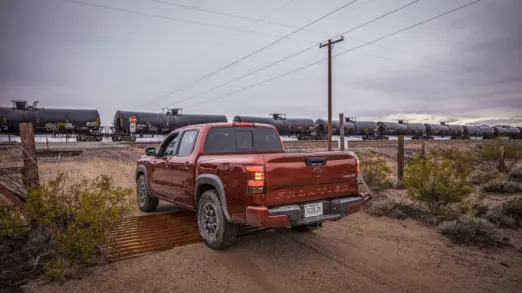
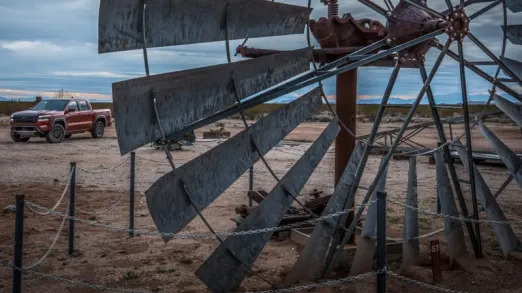
You gain 2,000 vertical feet in the first 10 miles of the trail as you approach the Piute Range, which is nothing when sitting in the heated seats of a modern-day vehicle. But Casebier, before realizing the best way to see the road was by four-wheeling it, hiked all 133 miles of it, in eight days, averaging 17 miles a day. “Twelve miles a day is enough,” he wrote. I’m no stranger to long treks in the mountains, but at least the mountains of Colorado have trees and therefore shade. Seventeen miles a day on sand in the unforgiving sun sounds brutal.
As we climbed higher in elevation, the bushes soon gave way to desert grasses, prickly pears, chollas, and the yucca that gives the nearby national park its name, the Joshua Tree. The road itself to this point was mostly unremarkable, as far as off-road challenges go. Occasionally you’d hear a clang of a skid plate when we were tooling along at a good speed, but the compacted sand and rocks we encountered were nothing for the Frontier to worry about. The 3.8-liter V6 faded into the background once we left pavement, the 310 horsepower and 281 pound-feet of torque more than enough for the slow driving we were doing.
Our first campsite, if you can call a place with running water, electricity and (somewhat spotty) Wi-Fi a campsite, sat outside the steps of the MDHCA in Goffs, Calif. As we pulled into town, which sits along historic Route 66, the welcome sign noted the local population was 23. After driving less than a mile to our campsite, I began to wonder if 23 was an overestimation.
After a tour of the Goffs Schoolhouse, which now serves as a museum and headquarters for the MDHCA, we ate a lavish dinner and sat around the campfire until the rain clouds threatened and I decided to call it a night. I crawled into my tent, threw on a few layers and looked at my watch. Shortly after 9 pm. I tried to figure out how to use a down sleeping quilt for the first time (best not to attempt in the dark) and as I closed my eyes the last thing I could hear was the patter of rain hitting the fly of my tent before falling asleep.
I must’ve been out for only a few minutes before I was awake again, thanks to the distinct, low-pitched and incredibly loud sound of an oncoming train warning anyone driving on Route 66 at this time of night that it wasn’t about to slow down. “On average 65 trains a day travel through Goffs,” we were told when driving over the tracks. More than a few of those were at night.
Despite the numerous trains, I thankfully get a restful night’s sleep, and after packing the truck back up, we head out again, single file. In less than a half hour we were back on the road.
Morning rays snuck through the rain clouds, lighting the Joshua Trees on either side of the trail as if by design. Occasionally we’d get up to speeds of 25 mph, only to be slowed by rocks and washouts. As the middle truck in the pack, we had warning of any large rocks or washouts, either through the radio or the clang of the skid plates ahead of us. More than a few times we found ourselves out of sight with the caravan ahead of us and the rest of the trucks behind, but the Mojave Road doesn’t split often, so it’s easy to catch up.
By mid-morning, the rain clouds had given way to a sky growing brighter and brighter, but as we continued west with the New York Mountains to our north and the Providence Mountains ahead, the threat of rain loomed again.
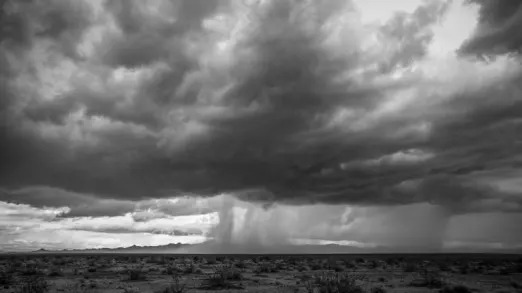
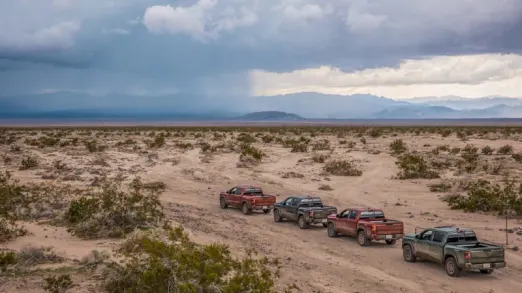
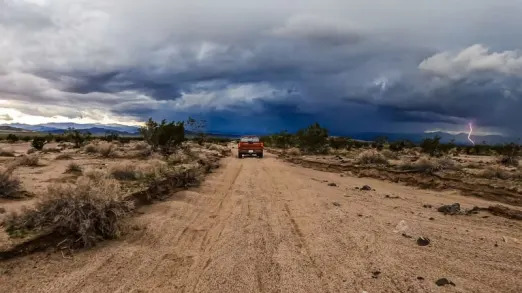

“Our timing was such that we had to hurry on,” wrote Casebier of the ‘83 caravan’s stop at Marl Springs. In that aspect not much has changed in the past 40 years. While our group of journalists had been leisurely moving along at roughly half the pace of a normal group of off-roaders, we significantly quickened the pace as the threat of torrential rainfall loomed. It was understandable, if a bit disappointing. By now we were driving on the soft sand near Willow Wash.
To our right was a spectacular sight: a 10-foot wall of black volcanic rock sealed us in on one side, the remnants of eruptions that took place thousands of years ago. Beyond the wall rising to an elevation of almost 6,000 feet was the dormant Cima Dome. At this point I was riding shotgun and admittedly forgot why we were actually here: to test the capabilities of Nissan’s latest midsize truck and learn about the road’s history. Instead, my mind wandered to what this area must’ve been like thousands, even millions of years ago. In such a large place that has been around for so long, it is easy to feel insignificant, because that’s exactly what we were.
As we thundered toward the river crossing and our final campsite of the trip at Afton Canyon, the sky thundered back, bolts of lightning streaking across the sky miles ahead. The rain wasn’t far behind, the downpour already having closed the Mojave Road through the Soda Lake dry lakebed. For the first time that day, we flipped the knob to two-wheel-drive, hopped on dry pavement and headed toward Baker.


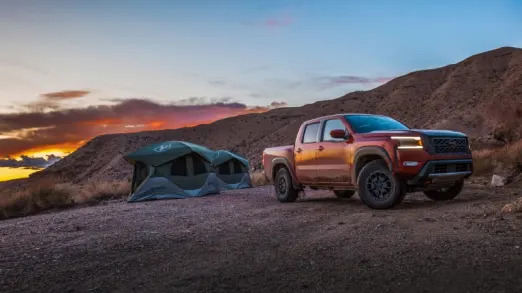
By the end of the day, the skies cleared, as did my fears that the trip might be cut short due to rain. As we drove on pavement to Afton Canyon, I couldn’t hide my disappointment that we weren’t going to be able to do the river crossing. During a dry season, the 2-foot-deep river provided a modest challenge. After the deluge we experienced these past few days, not to mention the uncharacteristic weather the region has seen this year, who knew how deep the crossing would be.
After dropping off our gear at our respective campsites, a few of us hopped in the truck to see what we were missing. After passing the railroad bridge we came upon the section of river, a currentless, stagnant area holding water that more resembled Yoohoo than the mighty Colorado at which we started our trip. On the surface, mosquitoes were buzzing around, sheltered from the wind by the tall grass on either bank.
I looked down the road to see our guide Sean heading toward us. He paused for a moment at the bank before making his way across, mixing the water as he went. Safely on the other bank he turned around and headed back the same way. The river had been crossed.
If you’re looking for a story about a truck getting stuck or having trouble making it over obstacles, this isn’t it (If you’re looking for a comprehensive review of the Nissan Frontier, you can find that here). We had only once put the trucks in 4 Lo; a mid-morning, sandy descent on day 2 that could only have been made more fun if we had turned around, climbed it, then drove back down it again. Other than that, it was 4 Hi all the way until we hit pavement. That said, thanks to the weather we didn’t travel the entirety of the Mojave Road, something that should be on every overlander’s bucket list.
Only one of the much-less-capable 1983 trucks got stuck back in the day and needed to be pulled out, so it should come as no surprise that the Frontier Pro-4X made this trek seem easy. It takes not much more than some off-road experience, a stock 4x4 vehicle, a tent, a sleeping bag, some food and water to start overlanding. The important thing is to get out there. No cellphone, no e-mail, and with only the environment to focus on, allows you time to reflect and reset. Or at least, have a ton of fun.
Related video:
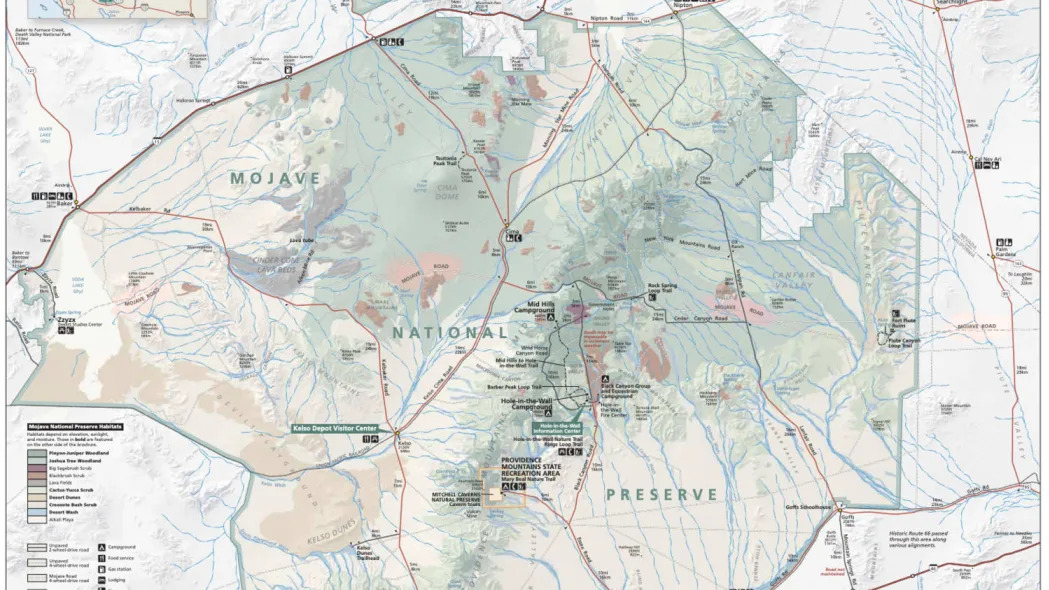



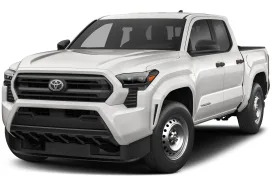
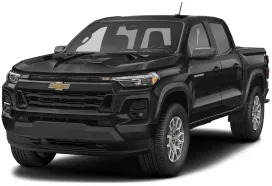

Sign in to post
Please sign in to leave a comment.
Continue